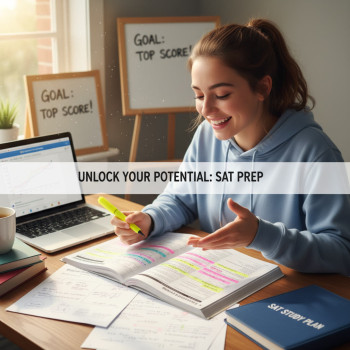Why Your SAT Practice Test Scores Don’t Stay Put (and Why That’s Okay)
If you’ve taken two — or ten — SAT practice tests, you’ve probably noticed something maddeningly human: your scores don’t move in a straight line. One week you hit a new personal best; the next week you slip back. The ride can feel unfair, confusing, or even a little cruel. The good news? Score swings are normal, informative, and fixable. This post explains the most common reasons practice-test scores fluctuate, how to diagnose the causes, and precise, practical steps to turn inconsistency into reliable improvement.
First, a quick reality check
The SAT is a complex, timed assessment that asks you to do three things at once: use content knowledge, apply strategic thinking under time pressure, and manage your mental state. Any change in those three factors — even a small one — can nudge your practice score up or down. Instead of panic, treat each practice score as a datapoint: useful, imperfect, and most powerful when viewed across several tests.
What’s a meaningful change?
Not every point swing is cause for alarm. Random variation is real. For many students, a 10–30 point change between tests is within normal noise; a consistent trend in one direction over multiple tests is what matters. Think about the pattern, not the single test.
Top reasons practice scores fluctuate (and how to spot them)
Below are the most common reasons scores move around, with signs to help you identify the culprit.
1. Test conditions: environment, timing, and fatigue
Taking a test at 9 a.m. after breakfast is not the same as taking one at 10 p.m. after a long school day. Noise, interruptions, screen brightness, and how well you’ve simulated test day all affect performance.
- Signs: big swings when you test at different times of day; better scores when rested; unexpected errors on easy questions.
- Fix: standardize your practice environment. Take at least one practice test under full-test conditions — same time of day, timed sections, device setup similar to Bluebook, and minimal distractions.
2. Test-taking strategy and pacing
The Digital SAT is adaptive and strategic time management matters. If your pacing varies, or you change strategies mid-test, your raw scores will reflect those choices.
- Signs: many skipped questions, abrupt timeouts on sections, lots of last-minute guessing or rushed answers near the end.
- Fix: practice pacing with section-level timers, review the number of questions you reach in each block, and practice targeted timing drills (e.g., 10–15 minute sprints on problem types that slow you down).
3. Content knowledge gaps and topic mix
Practice tests are not identical — some tests emphasize algebra, others focus on evidence-based reading or harder command-of-evidence questions. That mix will surface strengths and weaknesses differently.
- Signs: wild swings in section scores (e.g., Math up 60, Reading down 30); consistent misses on specific question types (word problems, punctuation, passage analysis).
- Fix: use score reports to identify patterns. Build focused micro-lessons for weak topics and cycle practice into your study plan — don’t study everything superficially.
4. Question difficulty and randomness
Not all practice tests are identical in difficulty. Over several tests, you’ll see normal variance caused by question selection. A single unusually hard section can drag a score down, even when your skills are improving.
- Signs: one or two unusually hard passages or problem clusters driving a score change, while your raw understanding hasn’t shifted.
- Fix: average scores over multiple tests and focus on trends. Use question-level reviews to understand whether errors were due to content or to misreading or timing.
5. Test anxiety and confidence swings
Confidence — or the lack of it — influences how you approach questions. Anxiety can slow your reading, lead you to overthink, or push you into panic-guessing when time becomes tight.
- Signs: mind blanks, second-guessing, hyper-focus on one question, deterioration late in the test.
- Fix: practice relaxation routines (deep breathing, pre-test rituals), simulate test day to build familiarity, and practice mindfulness to reduce catastrophic thoughts. Students who get 1-on-1 guidance often find anxiety reduces faster because they build both strategy and confidence.
6. Scoring and human error
If you’re self-scoring, mistakes in tallying answers or entering responses can cause false swings. Even in digital practice platforms, misunderstanding how adaptive scoring works can lead to misinterpretation.
- Signs: score changes that don’t match the number of questions you got right; inconsistent calculation methods.
- Fix: follow official scoring guides or verify your raw-answer counts. When possible, use official digital practice platforms that calculate scores for you.
7. Study variability: inconsistent preparation
Study in bursts, and your score will bounce. Consistency matters: regular, targeted practice beats sporadic cramming.
- Signs: large improvement after an intense week, then regression after a week off; scores that track study intensity.
- Fix: design a sustainable routine. Even 30–60 minutes most days is better than an exhausting 6-hour marathon once in a while. Consider a tailored study plan that balances review, new learning, and practice tests.
How to read your practice test results like a detective
Don’t treat a practice test like a verdict. Treat it like a forensic report. Here’s a step-by-step method to analyze each practice test so you learn more from it than the raw score shows.
Step 1: Record the context
Capture when, where, and how you took the test: time of day, device, breaks, sleep, food, stress level. These contextual details often explain variance.
Step 2: Compare section-level details
Look beyond the composite score. Which section moved the most? Was the change driven by a few questions or many small errors?
Step 3: Drill down to question types
Group your missed questions by type (e.g., linear equations, command of evidence, data interpretation) and by mistake pattern (careless reading, concept error, running out of time).
Step 4: Build a 7–14 day corrective plan
After each practice test, create a short plan targeting the top two weak areas and one habit problem (pacing, anxiety, carelessness). Keep the plan short — a focused repair works better than trying to fix everything at once.
Practical routines and drills to stabilize your scores
Here are evidence-based study moves you can implement right away to reduce variability.
Daily micro-practices (15–45 minutes)
- One active reading passage with timed annotation practice.
- Five targeted math problems from a weak topic, followed by immediate review.
- One timed grammar set (editing sentences), focusing on common traps.
Weekly habits
- One full section taken under timed conditions.
- 30–45 minutes of review on errors from that section (why each answer was wrong or right).
- Practice relaxation and pacing techniques for 10 minutes.
Every two weeks
- One full-length practice test under simulated conditions (same time of day, minimal interruptions, identical break pattern).
- Comprehensive review and a new 7–14 day corrective plan.
Use data to make better decisions: a simple score-tracking table
Track more than the composite score. Record section scores, question types missed, timing issues, and notes about conditions. Below is an example table format you can copy into a spreadsheet or notebook.
| Practice Test | Date | Reading & Writing | Math | Composite | Top 3 Mistake Types | Test Conditions / Notes |
|---|---|---|---|---|---|---|
| Test 1 | June 5 | 640 | 590 | 1230 | Data interpretation, comma splices, algebraic word problems | Well-rested, quiet, used Bluebook |
| Test 2 | June 21 | 600 | 620 | 1220 | Time pressure, misread questions, quadratic setup | Took after school, rushed |
| Test 3 | July 6 | 650 | 630 | 1280 | Significant progress on grammar, still slow on geometry | Simulated test day, practiced pacing |
How targeted tutoring and tailored study plans help
Many students find steady improvement faster when they combine self-study with focused coaching. Personalized tutoring accelerates this process in three ways:
- 1-on-1 guidance helps you zero in on the exact question types that cause swings, not just general weaknesses.
- Tailored study plans keep you consistent — scheduling the right mix of review, practice, and full tests so you don’t over- or under-prepare.
- Expert tutors provide actionable feedback and accountability that helps reduce anxiety and carelessness.
For students who want a structured, data-driven approach, Sparkl’s personalized tutoring blends expert tutors with AI-driven insights to accelerate diagnosis and create efficient practice cycles. When tutoring fits naturally into your routine, you get targeted problem sets, pacing drills, and confidence-building exercises — all designed to smooth out score volatility.
Examples: small changes that produce big stability
Here are three short case studies (composite examples based on common student experiences) showing how small tactical changes can turn wild swings into steady progress.
Case study A: The ‘late-night crammer’
Problem: Scores varied by 50–80 points depending on when the student took the test. Performance dipped after school days.
Solution: Standardize test time to Saturday morning practice, prioritize sleep, and shift heavy study blocks to earlier in the day. Add two simulated tests under those morning conditions.
Result: Within four weeks, score swings narrowed and averaged a steady upward trend as stamina and alertness stabilized.
Case study B: The ‘strategy switcher’
Problem: Student kept changing approaches to guessing and pacing, which caused inconsistent performance.
Solution: Pick one pacing strategy for two weeks (e.g., quick first pass, mark and move), track missed questions caused by time pressure, and refine the approach with targeted drills.
Result: Once pacing became consistent, careless errors dropped and score reliability improved.
Case study C: The ‘patchy practice’ student
Problem: Intense bursts of study followed by long breaks led to gains that evaporated quickly.
Solution: Switch to a sustainable daily micro-routine with built-in spaced repetition for weak topics and two full-length tests per month. Add periodic tutor check-ins to keep accountability.
Result: Long-term retention improved, and practice-test scores began to trend upward rather than oscillate.
When to worry — and when to relax
Worry if you see a persistent downward trend across multiple tests and consistent errors in the same domain despite corrective efforts. Relax if you see natural up-and-down variation but a clear upward trend over several weeks, or if your errors are random and explainable by test conditions.
Checklist: When to get extra help
- You have repeated test anxiety that doesn’t improve with relaxation routines.
- Scores bounce around more than 100 points with no identifiable cause.
- You hit a plateau despite focused study for 6–8 weeks.
Extra help doesn’t mean you’re failing — it means you’re optimizing. A few well-timed tutoring sessions can teach pacing strategies, correct deep content gaps, and introduce testing habits that pay off in consistency and higher scores.
Final words: turn fluctuations into feedback
Practice-test score swings are feedback, not final judgments. Treat each test as a lab experiment where you change one variable at a time — sleep, timing, pacing, or content focus — and observe the result. Over time, the noise fades and the signal emerges: steady improvement driven by deliberate practice, good data habits, and smart support when you need it.
If you want to accelerate that process, consider mixing focused tutoring into your plan. Personalized support — whether a few sessions to fix pacing, or a longer series for content mastery — is one of the fastest ways to shrink swings and build reliability. Sparkl’s personalized tutoring model, with 1-on-1 guidance, tailored study plans, expert tutors, and AI-driven insights, is designed to integrate naturally into busy student lives and help turn those frustrating fluctuations into predictable progress.
Above all, be kind to yourself. Progress is rarely linear, but it’s nearly always possible. With a few smart habits, the right analysis, and occasional targeted coaching, those practice-test swings will become small blips on the road to your target score.
Quick starting plan (30 days)
- Week 1: Baseline practice test under simulated conditions; record context and errors.
- Week 2: Two micro-practice sessions per day (content + timing); targeted review of top 3 error types.
- Week 3: Practice pacing drills; simulate test day once; check anxiety-reduction routines.
- Week 4: Final full-length test; compare trends; create the next 30-day plan focusing on weak areas.
Closing note
Your practice-test score is a moment in time, not your identity. Use it to learn, not to judge. The smarter you become at interpreting the data — the conditions, the patterns, the question types — the faster you’ll turn fluctuation into forward motion. And if you ever want a partner to diagnose those patterns and build a study plan that fits your life, targeted tutoring can be the key that steadies the swing and unlocks consistent gains.
Now go take a clean, calm practice test — and when you do, bring a notebook. The best progress begins with careful notes and one small change at a time.















No Comments
Leave a comment Cancel